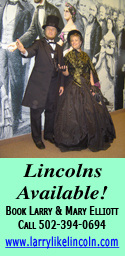|
|
Octagon Hall, built for distinction,
served as safe haven
for Confederate soldiers
There’s only one eight-sided house in Kentucky. Not surprisingly, it’s called Octagon Hall.
In 1847, Andrew Jackson Caldwell laid out the foundation for his new family home in Simpson County with a desire for distinction. His home would not be a simple structure with four walls, but an eight-sided edifice unique to the region.
Completed in 1859, it would soon become a landmark in the south-central Kentucky area.
Built for Caldwell’s growing family and as a headquarters for his plantation, it was occupied by the family even after Andrew's death in 1866.
Caldwell was very actively pro-Confederate and his brother was a colonel in the Confederate Army. The house was located on 31-W, known historically as the Nashville Road, and was a local landmark.
The Confederate Army evacuated Bowling Green, then the Confederate capitol of Kentucky, on Feb. 13, 1862. The army camped that night on the house grounds with some 8,000-10,000 men. Shortly after they departed, the Union army came in pursuit of the Southerners. However, the Union troops apparently were not in any hurry to confront the Confederates, waiting two days before arriving at Octagon Hall.
According to a granddaughter, the Union soldiers mistreated the family. They killed all their cattle, including Mrs. Caldwell’s favorite milk cow, “Old Spot.” And, they ate everything in sight.
What they did to the family as well as the slave women and children was never related.
However, they took the cattle carcasses and threw them into the wells so the water would be contaminated, forcing the family to get their water elsewhere. The Yankees also threatened to burn down their property, but Caldwell had enough brass to basically call their bluff.
“Go right ahead,” he said. “My brother just left and he’ll come back looking for ya.”
Obviously, the house wasn’t burned.
The county soon was occupied by the Union Army as the departing Confederates journeyed to Tennessee and on to Shiloh. Knowing Caldwell was a Confederate sympathizer, the Northerners harassed Caldwell and his family on a regular basis.
They often would sneak in to see if any Confederate troops were hiding there, which often was the case. Caldwell took in Southern soldiers who were wounded, needed hiding or food, who were separated from their commands, whatever the situation may be. If they could make it to the house, he would assist them in any way possible.
It was reported that when Caldwell heard about Union wagon trains traveling on the Nashville Road, he would have slaves plow the road to create ruts and holes in order to slow troop movements.
The house had many sufficient hiding places. A cupola, which was used for part of the airflow, also housed beehives. According to the granddaughter, Caldwell would put Confederate soldiers in bee suits and put them up with the bees. Whenever Union soldiers would open the trap door to the cupola, the bees would be swarming and the Union troops would back out quickly and not search the area.
Another hiding place was under the front steps. Part of the bricks had no mortar and served as an entrance to a crawl space.
During the war, the house also was a hospital in addition to serving as a sanctuary. Caldwell’s widow, Harriet, lived in Octagon Hall until 1918, then sold the house to Dr. Miles Williams, a Nashville osteopath. Williams made Octagon Hall his residence until his death in 1954. At that time, the structure was made rental property by his heirs.
The Octagon Hall Foundation was formed and obtained the building in 2001.
|
|
Sometimes, things
happen that are
hard to explain
Many houses and structures that survived the Civil War are said to be haunted. Octagon Hall is one of those.
One story concerns a young girl who burned to death in the fireplace while helping prepare a meal for the Caldwell family. During a 2003 Halloween ghost tour, a fireplace kettle, which hangs from a moveable arm, swung out into the room despite the fact that an extra effort is required to move the arm. It could not have done so on its own, spectators claim.
Then, there’s the image of a man riding in a wagon in the back yard. And, during a February re-enactment of the Confederate withdrawal from Bowling Green and the subsequent encampment at Octagon Hall, other strange things happened. A group of re-enactors decided to spend the night inside the house. Footsteps and the opening and closing of doors were heard throughout the night.
The next morning, they discovered that a feather bed in an upstairs bedroom had a deep imprint in the shape of a body, as if someone had slept there. But no one had. Several days later, the wife of one of the restorers of the home was alone cleaning the house and noticed the feather bed looked as if someone had been lying in it. She straightened it, and having not heard about the bed mystery from the previous weekend, thought nothing of it.
A little later, she returned to the room and was shocked to see that again the bed appeared as if someone had been lying in it.
On another occasion, a burglar alarm went off at the house. A police officer arrived to discover no sign of any intruders. Walking into one of the front rooms, the officer and one of the home’s restorers heard the doorknob to the parlor jiggling. The officer pulled his weapon and went to the other parlor door to get behind the intruder. But when he arrived, no one was there. The two watched as the doorknob turned and the door opened.
Dec. 15, 2003, was the date of Andrew Jackson Caldwell’s death, a time when embalming was not practiced. His body was displayed in the parlor, as was common at the time. At one point recently, the house suddenly filled with the odor of flowers, much like that at a funeral home. The odor was particularly strong in the parlor, although there were no live flowers in the house. A few minutes later, the odor changed to that of rotting meat, or the decay of a body.
Recently, the family of a five-year-old girl visited Octagon Hall. The girl wandered around the house and went downstairs. When she returned, she said there was a little black girl downstairs wearing a blue dress. She said the girl was hiding because she was scared. When asked why, she said the girl was scared because she had accidentally shot her brother.
Upon investigation, there was no girl in a blue dress to be found and there is no record of such an incident.
|
|
|












